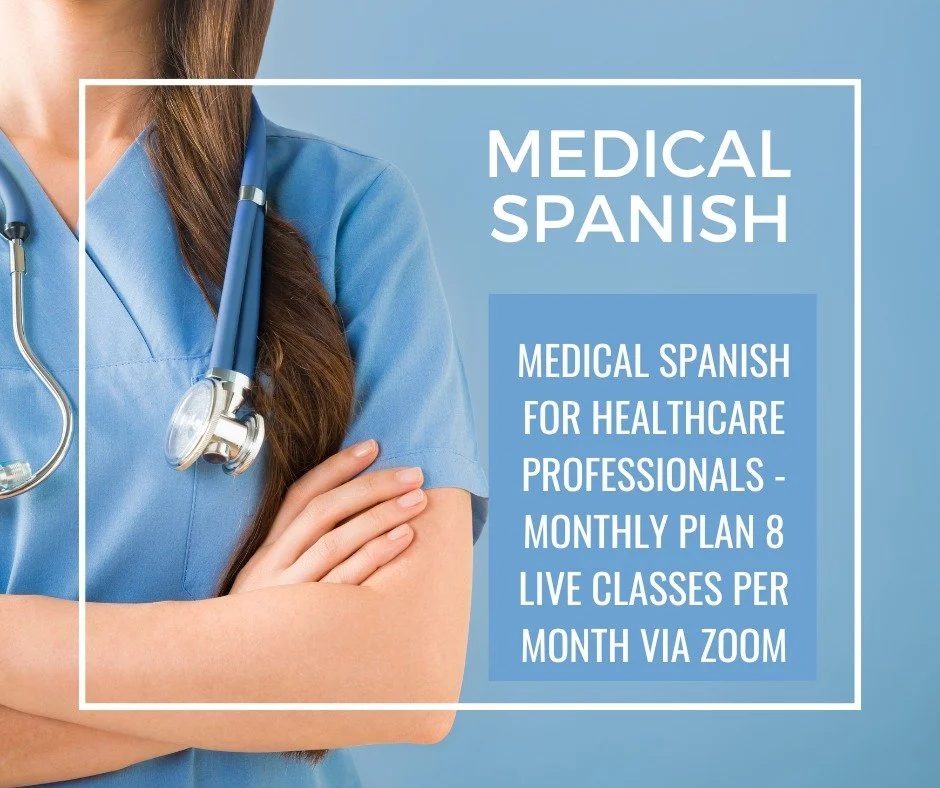Why Healthcare Professionals in the U.S. Learn Spanish
Across the United States, Spanish is no longer just a foreign language—it’s part of daily life in hospitals and clinics. In healthcare, words matter. A simple sentence can comfort, inform, or save a life. Yet, for many patients, those words don’t come in English—they come in Spanish. Over the years of teaching, I’ve seen doctors and nurses decide to learn Spanish not just as a skill, but as an act of empathy—a way to truly understand the people they care for.
My Experience Teaching Healthcare Professionals Online
It’s been many years since I started teaching Spanish as a second language. During this time, I’ve worked for global language companies and taught students from all over the world through online lessons. Each student brings a different background, story, and profession.
Over the years, I’ve noticed a clear pattern: most of the doctors and nurses who study Spanish come from the United States. They want to learn because they need it for their work—to communicate directly with their patients. In other countries, when I teach healthcare professionals, their motivation is usually more personal: a love for the language, travel, or cultural curiosity. But in the U.S., it’s different. There, learning Spanish is often a professional necessity, part of their daily reality in hospitals and clinics where many patients speak little or no English.
Because of that, I often work online with healthcare professionals—pediatricians, nurses, emergency workers, radiologists, oncologists, and others—who want to bridge that communication gap. They all share the same goal: to connect with their patients in Spanish, and to do it naturally and confidently. And that makes sense—because in healthcare, communication isn’t just helpful. It can be life-saving.
When Translation Isn’t Enough
Of course, there are tools that can help. Doctors can use translation apps or dictionaries, and many hospitals have interpreters on site or available through video calls. These resources are valuable and can make a real difference.
However, nothing compares to communicating directly with your patient. When doctors and nurses speak to their patients in Spanish, they can guide the conversation naturally, ask the right questions, and truly understand what’s going on.
Distinguishing between dolor leve (mild pain) and dolor agudo (sharp pain), or understanding whether someone feels ardor (burning) or cólicos (cramping), requires familiarity with the vocabulary—but also with how Spanish speakers actually describe pain in real life.
It’s More Than Vocabulary
Learning Spanish for healthcare isn’t just about memorizing lists of symptoms. Like in any language, there are many ways to describe the same feeling, and they vary depending on the patient’s background and Spanish variety.
This makes communication complex—and sometimes critical. Even with an interpreter, a small misunderstanding can change the meaning of what a patient is trying to express. The interpreter might know the vocabulary, but only the doctor or nurse can connect that information with the medical reasoning behind it.
That’s why fluency and direct understanding are so important. It’s not only about words—it’s about making sense of what the patient really means.
A Real Story
One of my long-term students once told me about something she witnessed at a doctor’s office. She isn’t a healthcare professional herself, but she speaks excellent Spanish after studying with me for several years.
While waiting for her appointment, she overheard a doctor trying to talk with a Spanish-speaking patient. The doctor knew some basic Spanish and was using a translation app to help. But even with the technology, they clearly weren’t fully understanding each other.
My student realized what was happening, but she didn’t feel confident enough to step in—after all, it was a medical conversation. That small moment revealed something powerful: technology can assist, but it can’t replace real human communication.
Why Real Communication Matters
Technology will continue to evolve—and that’s a good thing. Artificial intelligence and translation apps can make communication easier. But for now, they can’t capture the subtlety, empathy, or accuracy of human interaction—especially in healthcare.
That’s why learning Spanish as a healthcare professional isn’t just about studying; it’s about developing the ability to connect with your patients directly.
How I Teach Medical Spanish
As a Spanish teacher, I make sure to use the best educational resources, such as An Introduction to Medical Spanish by Robert O. Chase (Yale University Press), which includes a digital platform with exercises and videos.
But materials alone aren’t enough. My goal is to help you use Spanish actively—to talk about real healthcare situations and communicate with your patients in a clear and confident way.
I focus not on teaching grammar rules, but on helping you speak the language. Grammar exists to support communication, not to dominate it. And rules, like any theory, evolve to better describe how people actually use language. Speaking a language means using it—to convey meaning, to connect, to understand. That’s why my approach centers on interaction and real conversation from the very beginning.
Books and apps are great tools (I use them too), but they can’t replace the flow and rhythm of a live conversation. That dynamic exchange—the part where language becomes human—only happens when you talk to a real person. And when that conversation is guided by a professional teacher, it helps you focus exactly on the areas you need to grow.
Every student of a second language knows the difference between studying and using the language. For healthcare professionals, that difference can mean everything. It’s not about memorizing words or grammar—it’s about communicating in real, high-stakes situations.
That’s why I’ve built a Spanish learning experience that immerses you in the language from the very start. It takes time and energy, but it works.
It’s not about rules. It’s about people, communication, and real connection.

